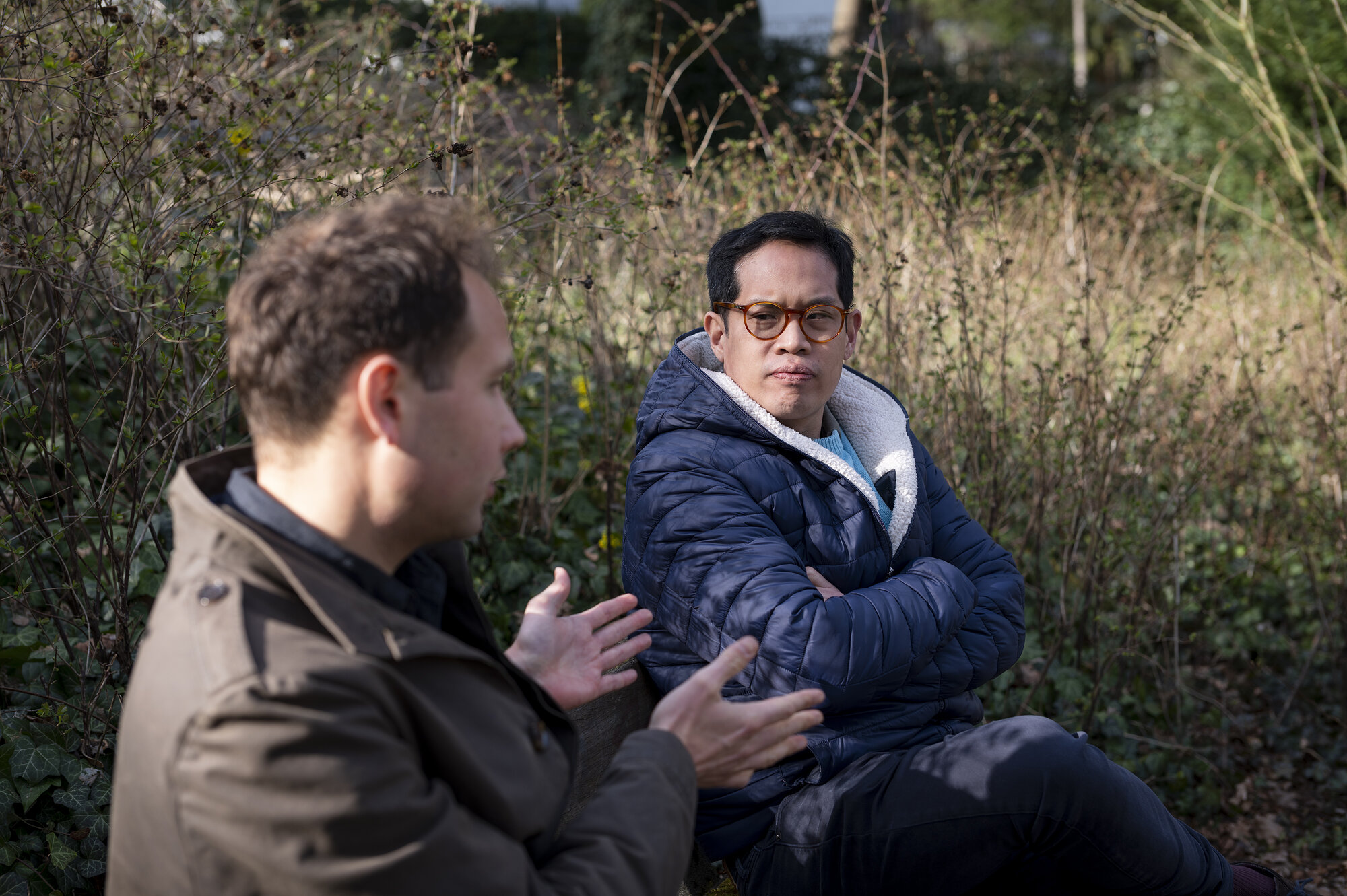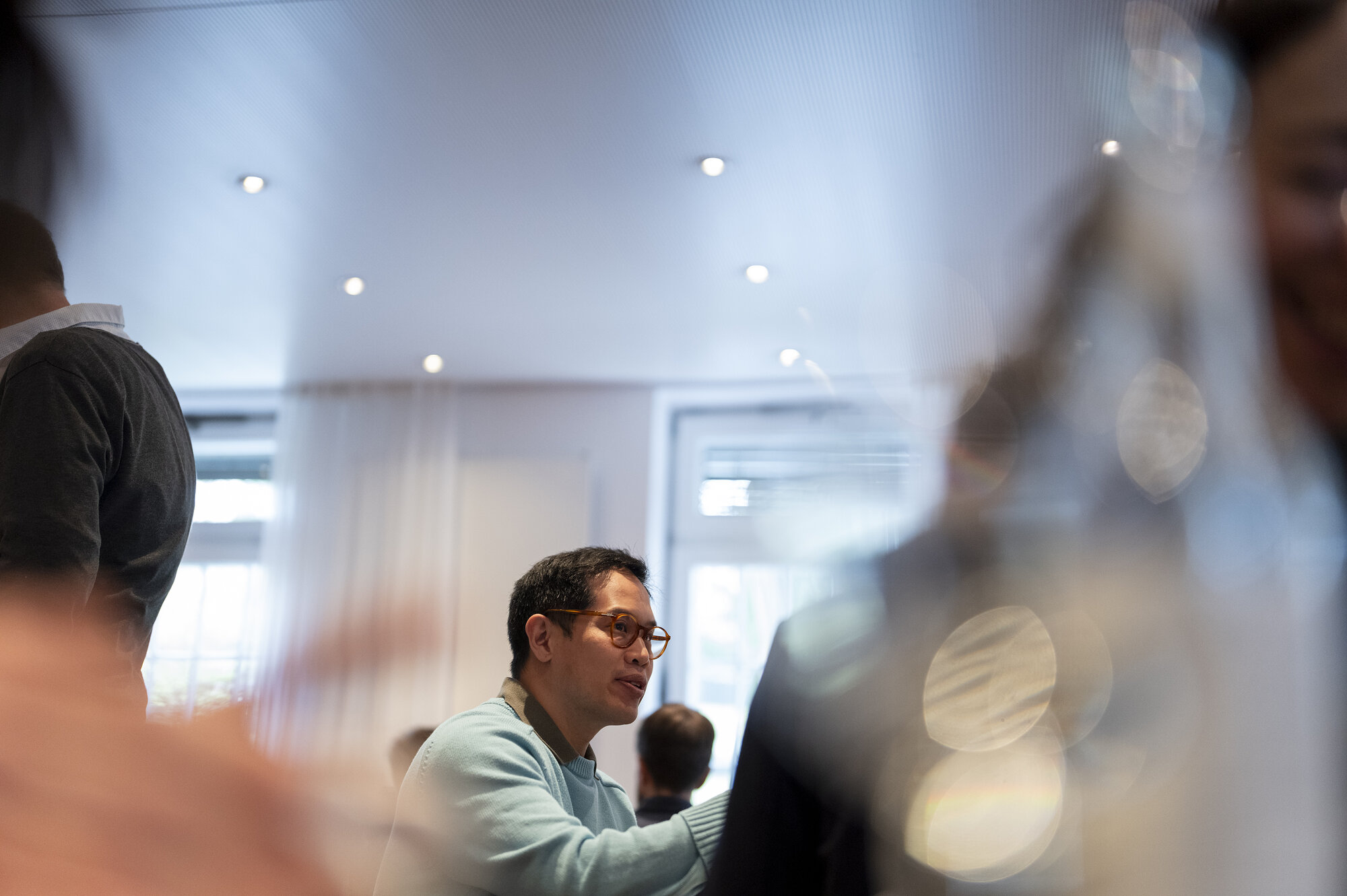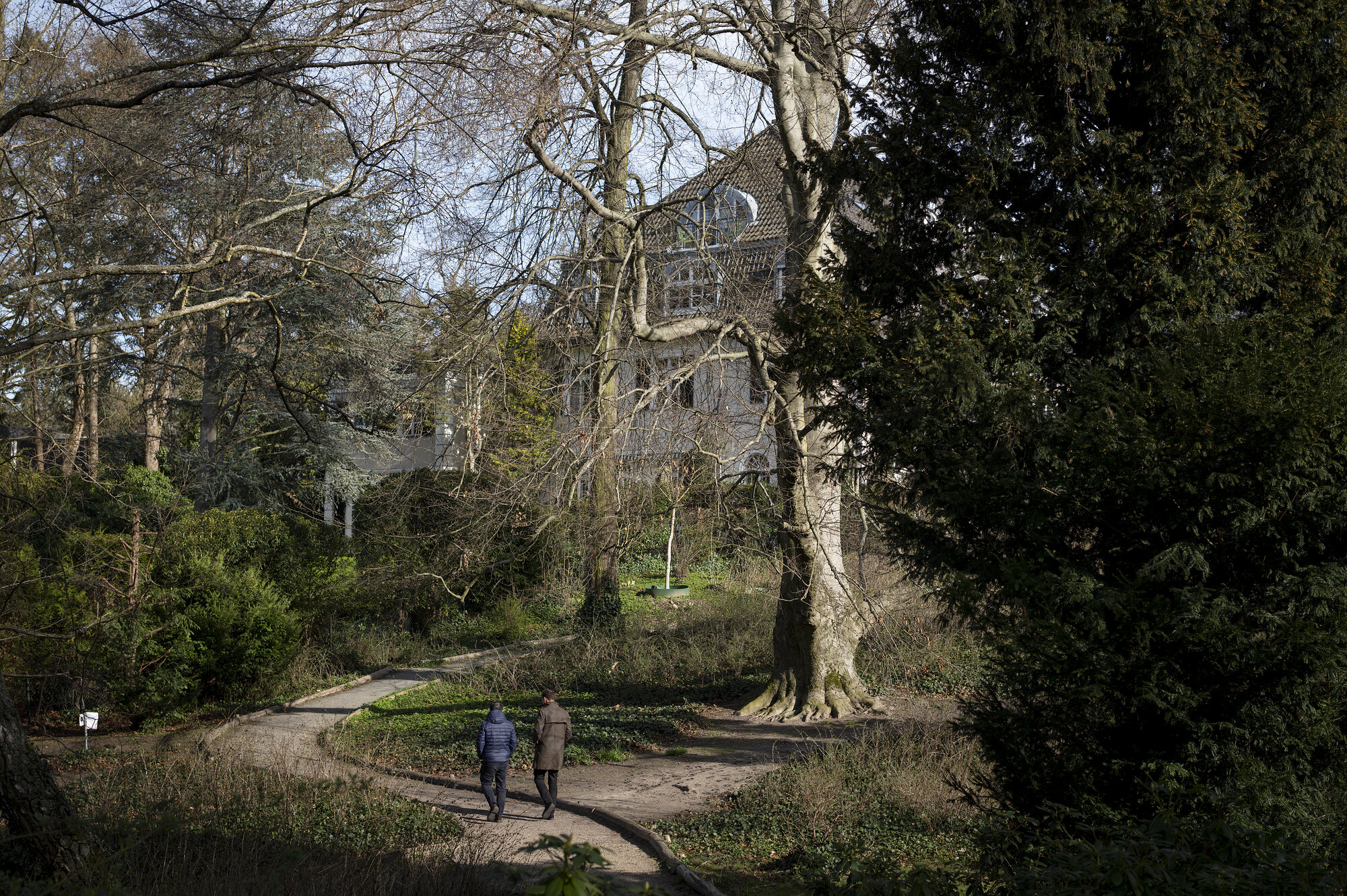Issue 19 / July 2024
Letter from Berlin
The Berlin Philharmonic and Me
The first CD set I bought with my own money was when I was 16. It was Herbert von Karajan’s 1963 recording of the complete Beethoven symphonies, purchased at Barnes & Noble, which had recently arrived in town. For a new immigrant from Hong Kong and a budding bookworm, a grand opening of a proper books-and-music store in a suburb of Dallas was somewhat of a big event. All the shiny books displayed on the shelves were so much more appealing than the moldy ones I found in the public library – I wanted to buy them all. The café inside served Starbucks beverages with exotic names like cappuccino, latte, and espresso – I wanted to try them all. There was a faux Art Deco mural of great authors like Franz Kafka, Oscar Wilde, and Virginia Woolf sitting around and having coffee – I wanted to read them all. The music section promised infinite riches inside flat jewel cases – I wanted to listen to them all. Perhaps by spending some money there, I thought, I too, could become cultured and sophisticated.
The 5 CDs came encased in a cardboard box of deep burgundy and burnished gold, the front cover of which was a profile of a perfectly coifed Karajan with his eyes down, dressed in black. This Deutsche Grammophon set formed the nucleus of my classical music collection. I somehow had picked up the 800 pages of The Penguin Guide to Compact Discs and devoted inordinate hours to the exegesis of its meticulously philological discussions of whether this or that recording of Böhm, Bernstein, or Abbado was superior. Of Karajan’s 1963 cycle, its reviewer praised it to high heavens. I spent so much time agonizing whether I should get the Anne-Sophie Mutter or Itzhak Perlman (or was it Gil Shaham or Maxim Vengerov?) rendition of the Mendelssohn violin concerto.
Baudelaire in the poem “Le Voyage” writes: “For the child, in love with maps and prints, the universe is equal to his vast appetite.” Adorned with posters and bric-a-brac, stacked high with CDs and paperbacks, my room formed a sort of late twentieth-century cabinet of curiosity assembled by an Asian-American teenager unusually and improbably interested in the elite culture of Europe. Though I didn’t have the right words at that time, what I was building was a Wunderkammer or studiolo out of the flotsam and jetsam of things I found at thrift stores and strip malls.
Today, I still buy too many books, posters, and postcards (but no music now because of streaming services). Since I can’t ever stay too long in Europe, I try to bring Europe home. For these things retain the nimbus of distance and express what the Germans call Sehnsucht, a yearning for something beyond one’s grasp.
So it was with considerable excitement that in my early forties I could finally see a performance of the Berlin Philharmonic in person. This was made possible by my fellowship at the Wissenschaftskolleg, which for me, because of the Co-Fellows and its location in the leafy Grunewald district, is an intellectual paradise.
To go from Grunewald to the Philharmonic is to traverse a slice of German history, for you move from the periphery of the formerly walled city to the edge separating West and East Berlin. As you start out in a tranquil neighborhood of woods and lakes, you can walk by the mansion of publisher Samuel Fischer or peek at stealth-wealth embassies. The Wiko is on Wallotstraße, named after Paul Wallot, the architect of the Reichstag. Imbedded on the sidewalks of many Berlin streets are Stolpersteine, stumbling stones, brass square plates inscribed with the names of persecuted or murdered Jews who had lived nearby. One in front of a Wiko villa commemorates Emmy Braun, who fled to Shanghai in 1940 only to perish in the Ghetto in 1943.
Hopping on the M19 bus, you go through the city’s main boulevard – the Kurfürstendamm, where the historic department store KaDeWe (Kaufhaus des Westens), overflowing with capitalistic goods, is the main anchor, and you pass the Kaiser-Wilhelm-Gedächtniskirche, now a ruined shard of a Romanesque-revival cathedral surrounded by profane commerce. You transfer to the M200, where you will pass the Zoo and the Tiergarten before you get off at the Herbert-von-Karajan-Straße stop.
When the hall of the Berlin Philharmonic opened in 1963, its surroundings were gritty and barren: unfinished parking lots, ugly dumpsites, and the Tiergarten, once a sprawling royal hunting ground, was by then a dilapidated park. In the late nineteenth century the area abounded with elegant mansions, hotels, art galleries, and embassies, a thriving home to both industrialists and artists, many of them Jewish. Huge blocks were demolished when Albert Speer, “the first architect of the Third Reich,” tried to realize the Führer’s megalomaniac masterplan of his imperial capital Germania. Further devastation came during the massive bombings by the Allied forces. Afterwards, a generation of postwar women called Trümmerfrauen, rubble women, cleared the site and deposited enough remnants of destroyed buildings for an artificial hill to be built in Grunewald called Teufelsberg, Devil’s Hill. Meanwhile, two hundred feet away from the Philharmonic was a freshly erected Wall.
Today, the area is utterly transformed. Potsdamer Platz is now a major transport hub with gleaming shopping, food, entertainment venues. The Philharmonic forms a part of the Kulturforum ensemble, which consists of the Gemäldegalerie, the Neue Nationalgalerie, the Staatsbibliothek, and other exhibition spaces. In construction is a new museum for twentieth century art designed by the renowned Swiss architects Herzog & de Meuron. This is next to the traditional St.-Matthäus-Kirche, which was rebuilt to its original form after being obliterated in World War II. Mies van der Rohe’s Neue Nationalgalerie, a late-modern, transparent, horizontal masterpiece, has just undergone a complete refurbishment by David Chipperfield, who also re-created the Neues Museum, part of the Museum Island in Mitte. The Staatsbibliothek, one of the largest libraries in Europe, will soon undergo a major renovation, which will no doubt be much delayed and overbudget, just like the recently opened Berlin Brandenburg Airport or the much-maligned Humboldt Forum. Clearly, the Kulturforum is still very much a work in progress.
The home of the Berliner Philharmoniker is properly called the Philharmonie. Clad in dimpled sheets of golden aluminum, it consists of two linked polygonal structures: the Great Hall and Chamber Music Hall (which opened two decades later), rising like shimmering pitched caravan tents. Their rooflines soar exuberantly like so many waves of musical notes. Designed by Hans Scharoun, its style anticipates the post-modern curves of the Sydney Opera House or L.A.’s Walt Disney Hall and defiantly rejects the neo-classical forms that characterized earlier concert halls and museums. Inside the foyer – with its coat-checks, multi-terraced staircases, waiting spaces, multi-colored stained-glass disks that make the interior aglow like a jewel box, and not least a very sensible bar and gift shop – people are encouraged to mingle and loiter. When I visited, the interior retained its vintage sixties décor well.
The fall and spring seasons, I went to about a dozen concerts. In his design proposal, Scharoun wrote that he wanted that “man, music, and space come together in a new relationship.” The site should follow “the pattern of a landscape.” Inside, the auditorium should be a “valley”: “at its bottom is the orchestra surrounded by a sprawling vineyard climbing the sides of its neighboring hills.” Its 2,440 seats are all arranged in asymmetrical terraces that radiate from the pentagon-shaped center stage.
The sound at the Philharmonie is phenomenal. Traditional halls are shoebox shaped, like the Vienna Musikverein, or a horseshoe, like Carnegie Hall, so the orchestra is on the one side and the audience on the other. Scharoun radically inverts this, “music in the middle” was his driving principle. Because the way the sound ricochets and blooms in the space, no matter where you sit, every note you hear is clear, vibrant, and focused. I was shocked by how Riccardo Minasi, making his Philharmonic debut, could, with a flick of his arm, command so sharp and sudden a fortissimo in Mozart’s Symphony No. 29, or how Gustavo Dudamel coaxed the gentlest gossamer pianissimo out of the adagietto of Mahler’s Fifth Symphony. I had many moments of low-grade euphoria, a tingling sensation in the back of the neck that is often associated with ASMR – Autonomous Sensory Meridian Response.
The new home of the Berlin Philharmonic and the divided city’s wall arose at the same time. The Philharmonie’s cornerstone was laid in September 1960. Eleven months later, in August 1961, construction of the Wall began. By the time of the Philharmonic’s opening in October 1963, the Wall had already completely encircled the French, British, and American sectors.
A divided city also meant a divided cultural heritage. At the height of the German Empire, the grand project of the Prussian kaisers was to bring art and culture to the new capital, an “Athens on the Spree.” Eventually the area in Unter den Linden (“Under the Linden Trees”) was home to an extraordinary collection of antiquities, along with a university, opera house, library, and cathedral. During World War II precious works were moved to the countryside for safekeeping. When the Wall came up, the sundered collections couldn’t be brought back together. This split, which remains today, prompts us to ask important questions about the fate of cultural institutions: Who decides what goes where – the federal government, state, or city? Why is great art concentrated in world capitals rather than distributed elsewhere? What dangers might there be in encyclopedic collections? Who are the victors and victims here?
So the Kulturforum was the Western contrapuntal response to the Soviet-controlled Museum Island. In contrast to the calm grandeur and noble simplicity of Unter den Linden, and in repudiation of the fascist grandiosity of Speer’s Germania, the many-sided Philharmonie must have been a shock: a trembling, dancing structure built amidst freshly cleared ruins. Whereas the neo-classical buildings in East Berlin reference directly their Mediterranean predecessors, the early post-modernism of Scharoun studiously avoids any allusions to the past. A new democratic state must have a tabula rasa for high art.
Thus it came to be that the Berlin Philharmonic played an essential role in the cultural politics of a divided city. What I realize now was that during the Cold War, Deutsche Grammophon’s recordings of Karajan and his orchestra was the West’s primary medium to broadcast to the world that music of the highest caliber was still possible there. By the 1990s, they eventually reached the ears of an Asian-American teenager living in Texas.
I must confess that me going to see live concerts was not, as special as they were, more epiphanic than me listening to recordings at home. Equally formative were those dark nights of the soul when I listened to Mitsuko Uchida when I was studying for my doctoral exams, or when I played Schubert’s Quintet in C continuously at an intensive summer language school. Bach’s French Suite No. 5 is indelible in my memory as the first piece I played after Trump’s victory. Not to be discounted are moments of passive listening when you’re filling out online forms or paying your bills, and not unimportant are the moments when you put on your headphones while you run your errands, and you feel like a super-hero in your own film.
What I experienced at the hall of the Philharmonie is perhaps best captured by what Freud wrote in the letter “A Disturbance of Memory on the Acropolis,” in which he remembers his first time going to Greece: “By the evidence of my senses I am now standing on the Acropolis, but I cannot believe it.” The feeling that overcame him was one of “derealization” – Entfremdungsgefühl – “So all this really does exist, just as we learnt at school!” It is not a very original piece of insight to say that seeing something with one’s own eyes is different from hearing or reading about it. But for Freud this difference has to do with how deep impulses within our unconscious shape our expectations and reactions. And at the Philharmonie, my mind ran a gamut of feelings: I can’t believe I’m here; I’ve worked so hard to come to this place; I don’t deserve this; oh, is this it? There are so many old people here, when is this concert going to end?
Audiophiles on social media fetishize recordings while my older white European colleagues fetishize live performances. The former are obsessed with the perfect album, I have been on social media groups where the comment feed of a post praising or denouncing a particular recording descends into disputations more befitting to the dark reaches of the far right. The latter are part of an increasingly small generation of Bildungsbürgertum, the educated bourgeoisie. They remind of Pierre Bourdieu’s argument that judgements of taste are largely shaped by one’s class.
Going to a concert, there is a regime of discipline: you have to be on time, you have to dress a certain way, you must not talk during the performance, but know when to clap (never in between movements). You might have social anxiety, if you go with other people you have to make small talk; or if you go alone that could be awkward as well. And if you’re on a budget you might feel guilty about spending too much money (though tickets in Berlin are in general much more affordable, since they are heavily subsidized by the state); or you might not like your seats or neighbors.
With recordings, you are in total control – I choose exactly the track I want; skip, repeat, compare fifty different versions of the Goldberg Variations on Spotify. Press the play button and from your speakers the most sublime sounds from the most brilliant performers since the history of recording technology will be at your beck and call. I have long given up the search of the “best” recording. There are those you listened to so often that they form your expectation of a piece, and so become the standard. Given a blind test, I’m not sure how many listeners except the most discriminating can distinguish whether it was András Schiff, Angela Hewitt, or Murray Perahia playing Bach.
In a New Yorker piece that Jiayang Fan wrote when the architect I.M. Pei died, she recounted the first time she saw Pei’s glass pyramid at the Louvre. Fan, like me, was a young Chinese immigrant to America. She visited France for the first time when she was a teenager: “I was an outsider there, by virtue of my face, my race, and the strange syllables that constituted my name. What I didn’t know at that jet-lagged moment was that the pyramid had been built by a man who once must have found himself similarly estranged.” And in an essay from Notes of a Native Son, James Baldwin, who had moved to France in his twenties, is speaking about the villagers he encountered: “The most illiterate among them is related, in a way that I am not, to Dante, Shakespeare, Michelangelo, Aeschylus, Da Vinci, Rembrandt, and Racine; the cathedral at Chartres says something to them which it cannot say to me, as indeed would New York’s Empire State Building, should anyone here ever see it. Out of their hymns and dances come Beethoven and Bach. . . . The cathedral at Chartres, I have said, says something to the people of this village which it cannot say to me; but it is important to understand that this cathedral says something to me which it cannot say to them.”
What does the Berlin Philharmonic say to me? While I can’t say that I’ve experienced the same hardship as Fan’s childhood or Baldwin’s racism, after all, Asians are well represented in classical music and I’ve been fortunate in my institutional affiliations, what I can say about the Berlin Philharmonic and me is that this one-sided relationship expresses a certain a sense of longing and belonging.
Since the eighteenth century, the Germans have put a lot of weight on the concept of Bildung, the process of development in which a person becomes at once an individual and a member of society through their enculturation. German pedagogy suggests that to be cultured you have to know the classics: the Greek and Roman classics and the Viennese classical style go hand in hand. Thus the history of concert going plays a large role in the shaping of Bildung.
What the Germans call cultivation of the soul, I call longing and belonging. Bildung makes you long for autonomy but it is culture that makes you belong to a community. My father supported us by first owning a Chinese bakery and then a goldfish aquarium shop. In my bedroom in Garland, Texas, I realized that I would never really fit in my high school or the Chinese Protestant church which we went to every Friday evening for fellowship and Sunday for worship. I know I wanted to be elsewhere, but just not where. Reproductions and recordings are at heart surrogates: You have to read or listen to something because you weren’t there yourself. It wasn’t just the Berlin Philharmonic, but the entire infrastructure of its lifeworld to which I sought access.
But the more I learned about the history of the orchestra, the more it demonstrated to me the essential truth of Walter Benjamin’s aphorism: “There is no document of civilization which is not at the same time a document of barbarism.”
Founded in 1882, its original name was an act of defiance: “The Former Bilse’s Ensemble,” to spite their former music director Benjamin Bilse who didn’t pay the players enough. The orchestra first played light fares in an open-air restaurant and a former roller-skating hall. When, decades later, they attained their world-class status, they became the “Reich’s Orchestra.” Joseph Goebbels, the Minister for Propaganda, was named its personal “protector.” Wilhelm Furtwängler conducted Beethoven’s Ninth Symphony for Hitler’s birthday. The orchestra performed in the Nuremberg Rallies and the opening of the 1936 Olympic Games. Just before the Battle of Berlin in the dying throes of the war, they played Brünnhilde’s immolation scene from the finale of Wagner’s Götterdämmerung. It was reported that the Hitler Youth handed out cyanide capsules to everyone. Leo Borchard, who conducted that final concert, was later accidentally killed with a shot in the head by an American soldier.
I had known none of this when I was a teenager.
After such knowledge, what forgiveness? I don’t know. Despite all of this, I do know that art renews itself and arises from a yearning for something beyond itself, and culture is forged precisely out of ruins and devastation. “Monument” in German is Denkmal, which has its root in denken, to think. The Wall fell on November 9, 1989. The Tiananmen Square student massacre occurred on June 4, 1989. My family immigrated from Hong Kong to the U.S. on July 1, 1989. Lack is the beginning of desire; death is the mother of beauty; beautiful things are difficult and easily broken. . .
German philosophy has expended much energy in thinking about the relationship between aesthetic experience, history, and the self. And with the advent of sound recording, we’re talking about how to capture and distribute a particular performance across the expanse of the planet to as many people as possible. We are talking about the ability of a medium to record and preserve sound, and how every time we press the play button, we activate encoded data. A complex set of transmission had to happen for the sounds of the Philharmonic to reach my ears: the economics which sustain the orchestra, the quality of its players, the acoustics of the hall, a conductor’s interpretation of a musical score, the composer and the lifeworld from which it springs, the state of recording technology and the audio equipment that are in your possession. The more you uncover its layers, the more complex the conditions which give rise to this musical event. You’re almost paralyzed by the miracles, nightmares, monuments of history. You wonder how any of this can happen at all.
In the early essay “On the Use and Abuse of History for Life,” Nietzsche had several models of understanding the burdens of the past: the antiquarian tries to preserve every minutiae, the monumental bulldozes everything in order to valorize the hero, the critical despises and rejects everything but doesn’t offer a better alternative. What is really needed, Nietzsche thought, is a history that serves to enhance living, breathing human beings. In the twilight of his creative years, before he lapsed into a decade-long coma, he wrote in The Genealogy of Morals that “in order for a temple to be built, an old one must be destroyed.”
The year I was in Berlin was the year of Hamas’ attack on Israel and Israel’s retaliation in Gaza. It was two years deep into Russia’s invasion of Ukraine; it was the eve of the Trump–Biden rematch; A.I. continued its tsunami onslaught; the encroaching strength of the AfD menaces civil society. Perhaps years later we can look back and perceive a pattern or arc that made future events inevitable. The experience of anything – whether it be aesthetic or not – involves both forgetting and remembering. We can be paralyzed by the agony of choice: which of the many concerts or events can I go to this evening? In the infinite catalog of YouTube, what shall I select? What’s the background story of this piece or that orchestra? We would be totally overwhelmed by the past were we to constantly have to find out about everything. To have a total aesthetic experience you must completely immerse yourself in the activity in which the demands of both the past and the future, as well as your identity, must recede. Is the ideal listening then, whether inside the concert hall or inside your noise-cancelling headphones, to forget who is performing, forget who you are, and become the music itself?
More on: Andrew Hui
Images: © Maurice Weiss





